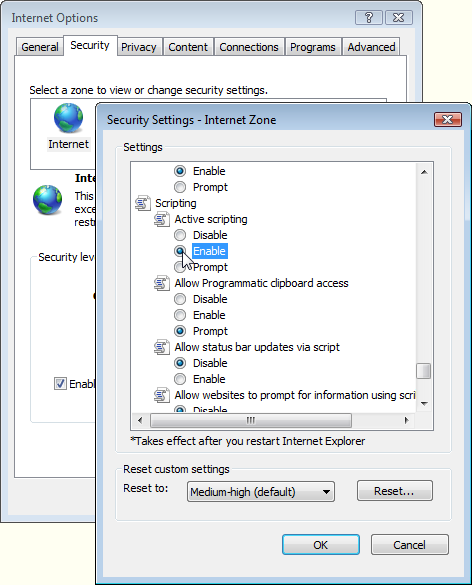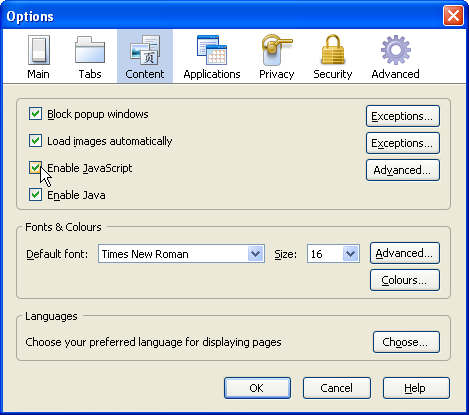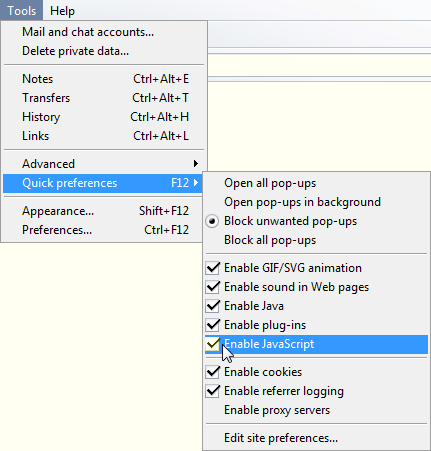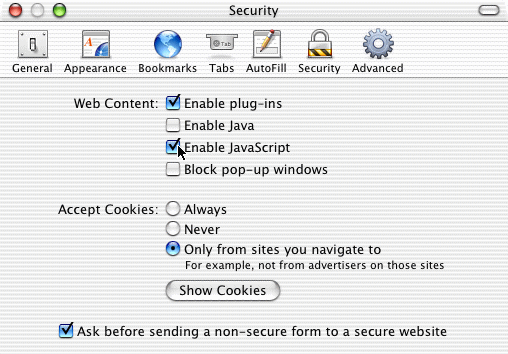How to enable your browser's JavaScript
Internet Explorer 7
- Open the “Tools” menu.
- Select “Internet Options”, to open the Internet Options dialog box.
- Click the “Security” tab.
- Click the “Internet” symbol (a globe).
- Click the “Custom Level…” button, to open the Security Settings dialog box.
- In the Settings list, scroll down to “Scripting”.
- Under Active Scripting, click the radio button to the left of “Enable”, so
that a coloured dot appears in it. (Click “Disable” if you want to disable
JavaScript.)

- (If you are unsure about the other Security Settings, please check with your Network Administrator.)
- Click “OK” to close the Security Settings dialog box.
- Click “Yes” in the Warning! message box.
- Click “OK” to close the Internet Options dialog box.
Internet Explorer 6
- Open the “Tools” menu.
- Select “Internet Options…”, to open the Internet Options dialog box.
- Click the “Security” tab.
- Click the “Internet” symbol (a globe).
- Click the “Custom Level…” button, to open the Security Settings dialog box.
- In the Settings list, scroll down to “Scripting”.
- Under Active Scripting, click “Enable”, so that a dot appears next to it.
(Click “Disable” if you want to disable JavaScript.)

- (If you are unsure about the other Security Settings, please check with your Network Administrator.)
- Click “OK” to close the Security Settings dialog box.
- Click “Yes” in the Warning! message box.
- Click “OK” to close the Internet Options dialog box.
Firefox
- Open the “Tools” menu.
- Select “Options…”, to open the Options dialog box.
- In the row of coloured icons at the top, click “Content”.
- Click the check box to the left of “Enable JavaScript” so that a tick
appears. (Click again to remove the tick if you want to disable
JavaScript.)

- Click “OK” to close the Options dialog box.
If you are using Mac OS X, then you need to select Preferences… on the Firefox menu, instead of Options… on the Tools menu.
Opera
- Open the “File” menu (version 6) or the “Tools” menu (versions 7, 8 and 9).
- Point to “Quick preferences”.
- In the submenu that appears, click “Enable JavaScript” to add or remove
the tick.

If you are using Mac OS X, then you need to select “Quick preferences” on the Opera menu, instead of the Tools menu.
Safari
- Open the Safari menu (OS X), or the “Edit” menu (Windows).
- Select “Preferences…”
- In the Preferences dialog box, click the Security icon (a
padlock).

- In the Web Content section, click the check box next to “Enable JavaScript” so that a tick appears. (Click again to remove the tick if you want to disable JavaScript.)
- Close the Preferences dialog box by clicking the red button at the top left (OS X) or by clicking the X icon at the top right (Windows).
